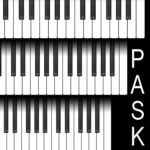Epidemiological and clinical studies - hand size as a risk factor
Much of the literature linking hand size with piano playing is in the field of performing arts medicine, with the focus on hand size as a possible risk factor in piano-related pain and injury. Many epidemiological studies published during the 1980’s and 1990’s covered a mix of instrumentalists rather than just pianists. Likely causes of pain or injury were identified as being technique, time and intensity of practice, posture and genetically based factors. Females were found to be disproportionately affected and keyboard players among those most at risk, with females being affected approximately 50% more than males. Some studies have found that 70-80% of female pianists are affected by playing-related pain or injury at some stage during their lives.
Sakai (1992) conducted a clinical study of pianists who presented with hand or forearm pain due to piano playing. He was one of the first authors to suggest that hand size may be a risk factor for piano-related pain and injury, and that Japanese pianists may be at a disadvantage compared with American and Europeans. Sakai later (2002) reported on a larger clinical study of 200 Japanese pianists, confirming his earlier findings and noted that playing octaves and chords involves hyperabduction (maximum movement away from a neutral position) of the thumb and fifth finger, which in turn affects the wrist, potentially causing de Quervain’s disease or other overuse problems.
About two decades ago, epidemiological studies of pianists (for example, De Smet et al., (1998), Farias et al., (2002) and Shields & Dockrell (2000)), started to identify hand size as a likely risk factor in piano-related pain and injury. Since Peter Bragge’s (2005) critical review of the literature on risk factors for piano-related injury, further investigations of risk factors for piano-related pain in injury have been published.
Yoshimura et al. (2006) investigated the relationships between pain and several independent playing-related and anthropometric variables among college students, and established a statistically significant relationship between piano-related pain and a general ‘size/strength/speed’ risk factor. Hand size and in particular, the 3-4 digit span, were encompassed within this risk factor. The results of a similar study (Yoshimura et al., 2008) involving piano teachers confirmed the link between hand size/strength and pain. Bruno et al. (2008) conducted a case-controlled survey of musculoskeletal disorders among piano students in Italy. Multivariate analysis found a statistically significant correlation between disorders of the upper limbs and hand size.
Sakai’s most recent research (2010) indicates that thumb hyper-abduction and extension is likely to cause lateral epicondylitis, forearm extensor pain and de Quervain’s disease in small-handed pianists.
Recent research (Ranelli et al.,2011) on pain and injury among young instrumental musicians (including pianists) shows that children are likely to be similarly affected as adults.
For a more comprehensive review of this literature up until 2008, see Boyle & Boyle, (2009).
References
Allsop, L., & Ackland, T. (2010). The prevalance of playing-related musculoskeletal disorders in relation to piano players’ playing techniques and practising strategies. Royal Northern College of Music, Music and Health, 3 (1), 61-78.
Blackie, H., Stone, R., & Tiernan, A. (1999). An investigation of injury prevention among university piano students. Medical Problems of Performing Artists, 14, 141-149.
Boyle, R., & Boyle, R. (2009). Hand size and the piano keyboard. Literature review and a survey of the technical and musical benefits for pianists using reduced-size keyboards in North America. Proceedings of the 9th Australasian Piano Pedagogy Conference: Expanding Musical Thinking. Sydney, Australia. https://appca.com.au/proceedings/proceedings.html
Bragge P., Bialocerkowski, A., & McMeeken, J. (2006). A systematic review of prevalence and risk factors associated with playing-related musculoskeletal disorders in pianists. Occupational Medicine, 56 (1), 18-27.
Bragge P., Bialocerkowski, A., Holtham, I., & McMeeken, J. (2006). Piano teachers’ perceptions of risk factors associated with injuries in elite pianists. Australian Journal of Music Education, 1, 70-81.
Bragge P., Bialocerkowski, A., & McMeeken, J. (2006). Understanding playing-related musculoskeletal disorders in elite pianists. Medical Problems of Performing Artists 21 (2), 71-79.
Bruno, S., Lorusso, A., & L’Abbate, N. (2008). Playing-related musculoskeletal disorders in young and adult classical piano students. International Archives of Occupational and Environmental Health, 81 (7), 855-860.
Cayea, D., & & Manchester, R. (1998). Instrument-specific rates of upper-extremity injuries in music students. Medical Problems of Performing Artists, 13 (1), 19-25.
Chesky, K., Yoshimura, E. & Furuya, S. (2007). Hand size and PRMDs in Japanese female pianists. (Letter to editor). Medical Problems of Performing Artists, 22 (1), 39-40.
Chorea, L.T., dos Santos, L.T., Paranhos, E.N.N., Albertini,A.I.M, Parreira, P.C.S and Nogueira, L.A.C.(2018). Prevalence and risk factors for musculoskeletal pain in keyboard musicians: A systematic review. PM&R Journal, 10,942-950.
De Smet, L., Ghyselen, H., & Lysens, R. (1998). Incidence of overuse syndromes of the upper limb in young pianists and its correlation with hand size, hypermobility and playing habits. Chirurgie de la Main, 17 (4), 309-313.
Farias, J., Ordonez, F.J., Rosety-Rodriguez, M., Carrasco, C., Ribelles, A., Rosety, M., Rosety, J.M., & Gomez del Valle, M. (2002). Anthropometrical analysis of the hand as a Repetitive Strain Injury (RSI) predictive method in pianists. Italian Journal of Anatomy and Embryology, 107 (4), 225-231.
Fry, H.J.H. (1986). Prevalence of overuse (injury) syndrome in Australian music schools. British Journal of Industrial Medicine, 44, 35-40.
Furuya, S., Nakahara, H., Aoki, T., & Kinoshita, H. (2006). Prevalence and causal factors of playing-related musculoskeletal disorders of the upper extremity and trunk among Japanese pianists and piano students. Medical Problems of Performing Artists, 21 (3), 112-118.
Kaufman-Cohen, Y., Portnoy, S., Sopher, R., Mashiach, L., Baruch-Halaf, L. & Ratzon, N. (2018). The correlation between upper extremity musculoskeletal symptoms and joint kinematics, playing habits and hand span during playing among piano students. PLOS ONE 13 (12). https://journals.plos.org/plosone/article?id=10.1371/journal.pone.0208788
Lai, K.-Y., Wu, S.-K., Jou, I. M., Hsu, H.-M., Chen Sea, M.-J., & Kuo, L.-C. (2015). Effects of hand span size and right-left hand side on the piano playing performances: Exploration of the potential risk factors with regard to piano-related musculoskeletal disorders. International Journal of Industrial Ergonomics, 50, 97-104.
Manchester, R.A., & Flieder, D. (1991). Further observations on the epidemiology of hand injuries in music students. Medical Problems of Performing Artists, 6, 11-14.
Pak, C.H. & Chesky, K. (2001). Prevalence of hand, finger, and wrist musculoskeletal problems in keyboard instrumentalists. The University of North Texas Musician Health Survey. Medical Problems of Performing Artists, 16 (1),17- 23.
Quarrier, N.F. (1995). Survey of music teachers: perceptions about music-related injuries. Medical Problems of Performing Artists, 10, 106-110.
Ranelli, S., Straker, L. & Smith, A. (2011). Playing-related musculoskeletal problems in children learning instrumental music. Medical Problems of Performing Artists, 26 (3), 123-139.
Sakai, N. (1992). Hand pain related to keyboard techniques in pianists. Medical Problems of Performing Artists, 7, 63-65.
Sakai, N. (2002). Hand pain attributed to overuse among professional pianists: a study of 200 cases. Medical Problems of Performing Artists, 17(4), 178-180.
Sakai, N., Liu, M., Su, F., Bishop, A. & An, K. (2006). Hand span and digital motion on the keyboard: concerns of overuse syndrome in musicians. The Journal of Hand Surgery, 31 (5), 830-835.
Sakai, N., & Shimawaki, S. (2010). Measurement of a number of indices of hand and movement angles in pianists with overuse disorders. The Journal of Hand Surgery, 35 (6), 494-8.
Shields, N. & Dockrell, S. (2000). The prevalence of injuries among pianists in music schools in Ireland. Medical Problems of Performing Artists, 15 (4), 155-160.
Wood, G.C. (2014). Prevalence, risk factors and effects of performance-related medical disorders (PRMD) among tertiary-trained jazz pianists in Australia and the United States. Medical Problems of Performing Artists, 29 (1), 37-45.
Yoshimura, E., Paul, P.M., Aerts, C. & Chesky, K. (2006). Risk factors for piano-related pain among college students. Medical Problems of Performing Artists, 21 (3), 118-125.
Yoshimura, E., Fjellman-Wiklund, RPT, Paul, P.M., Aerts, C. & Chesky, K. (2008). Risk factors for piano-related pain among piano teachers. Medical Problems of Performing Artists, 23 (3), 107-113.
Zaza, C. & Farewell, V.T. (1997). Musicians’ playing-related musculoskeletal disorders: an examination of risk factors. American Journal of Industrial Medicine, 32, 292-300.
Zaza, C. (1998). Playing-related musculoskeletal disorders in musicians: a systematic review of incidence and prevalence. Canadian Medical Association Journal, 158 (8), 1019-1025.
Zhao, L., Wang, Y. & Zhang, Z. (2024). Playing-related musculoskeletal disorders among Chinese conservatoire piano students: prevalence, risk factors and preventative interventions. Frontiers in Psychology, October 2024. https://pubmed.ncbi.nlm.nih.gov/39469245/


